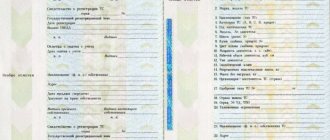Document year: 2019
Document group: Acts
Type of document: Acts
Download formats: DOC, PDF
Automobile acts confirm that one person transferred a vehicle to another, provided services or necessary work on the vehicle. Similar documents are drawn up for any moving vehicle: from a moped to a truck. The parties involved can be different categories of persons; the act is drawn up between legal entities and between private individuals. Also, documentation of the transfer of a car can be drawn up if one participant is an individual, and the second is a legal entity.
Such acts are drawn up in different life situations: from sale to transfer of a car for repair or service. Papers are also drawn up to inspect the technical condition of the machine. Such documents are needed after transport accidents, for issuing insurance policies, and for inspection by the traffic police.
We will analyze in detail the different types of acts, consider what is written in such documents, as well as their samples.
Car acceptance certificate
Acceptance and transfer of a vehicle can be carried out upon a change of owner (during sale under a purchase agreement), upon a change of owner (under a rental agreement, leasing), for transfer of the vehicle to a car service center.
Legal relations can be between legal entities and individuals, or in mixed agreements. These are cases when one person is a legal entity and the other is a private person. Such situations are the most common: a legal entity - a car service center, a car dealership or an official dealer. For individuals, legal relations mainly relate to the purchase and sale of used cars.
The most common case is a change of owner under a purchase and sale agreement. It is believed that the acceptance certificate is an optional document when conducting such transactions. However, without it, it is impossible to terminate the contract through legal proceedings. This is especially true in cases where the document does not include clauses regarding the acceptance and transfer of the vehicle.
Thus, the fact of a change of owner can be confirmed in two ways:
- describe this in detail according to the text of the contract;
- draw up an act of acceptance and transfer of funds.
In this case, the last point is the most desirable. The act will become an annex to the contract; it must describe in detail the technical characteristics of the vehicle, interior decoration, obvious defects and breakdowns, as well as agreement that the receiving party has no claims against the transferring party. And this fact is confirmed by the signatures of the participants.
The paper is compiled according to the number of sides. Usually two versions are printed. You can do it for free, which will be standard when transferring a vehicle from one driver to another (with or without transfer of ownership).
The same paper can be drawn up if property is transferred under a gift agreement. The fact is that with this document various written agreements take on legal force and can only be broken through legal proceedings. For example, if the buyer believes that the seller has violated his rights as a consumer.
Let's consider special cases of drawing up acts.
Certificate of acceptance of the car to the car service center
The transfer of the vehicle for repair and maintenance must be confirmed by a transfer deed. Most service stations neglect this. However, in the future, if claims arise, oral agreements will not be valid, and it will be impossible to challenge your position in court, referring to them.
Any major service will issue an acceptance certificate for repairs and maintenance without reservations.
The document specifies standard settings:
- information about the paper (date and place of signing, which agreement is attached);
- brief description of technical characteristics;
- description of completeness, operability and appearance (a schematic drawing is used);
- the estimated completion time of the work is indicated;
- Additional comments are given, spare parts are indicated that the client sends for repair (if sent).
The document is endorsed by the parties.
There is no single paper sample, so each service station uses its own template, but the information described above is common to most stations.
Act to the lease agreement
Temporary use of the car is fixed in the rental agreement, and the actual transfer and further return is prescribed in the transfer deed and the return deed.
Each landlord uses their own rental template. Usually these are generally accepted norms when transferring a vehicle: an indication of which contract is being transferred, when and where the appraisal report was drawn up, details about the rented car (technical characteristics, defects, inventory of internal components, malfunctions).
Renting a car is risky for both parties: the lessor can protect himself in case of possible damage, the renter can protect himself when returning the car, so that the owner does not blame him for damage that he did not cause.
What is a car acceptance certificate?
The vehicle acceptance certificate is not an independent document. It is inextricably linked with the car purchase and sale agreement and becomes its annex.
The function of the transfer act is to:
- confirmation of the actual transfer of property:
- recording the condition of the property on the date of transfer;
- assurance that the transaction has been completed, the technical condition of the object is known, an inspection has been carried out, and the parties have no claims against each other.
At the moment of signing the vehicle acceptance certificate, the party to the contract receives the corresponding rights and obligations to dispose of it. The document does not require notarization; the signatures of the parties are sufficient.
Vehicle inspection report from the traffic police
The inspection report is used by the State Traffic Inspectorate to register the vehicle. Often the procedure is carried out when there is a change of owner in various legal relationships: donation, purchase, etc.
To do this, the vehicle is first inspected by a traffic police officer and a specialized technician. The inspection form records:
- identification data (make, VIN, engine code, etc.);
- brief description (color, year of manufacture);
- date and location of inspection;
- the text of the act describes in detail the condition of the car: defects, malfunctions, breakdowns, possible breakdowns in the future, the general condition of the car outside and inside, the causes of malfunctions.
At the end, the persons who were present during the inspection are listed and they endorse the document.
Certificate of inspection of the technical condition of the car
After inspecting and assessing the technical condition of the machine, the result of this procedure is the drawing up of a report. The document describes in detail: the condition of the body, bumper, tires, headlights, gearbox and other elements of the car. Present and future car malfunctions are described.
Drawing up such an act can be:
- one-time, for example, after a traffic accident;
- periodic. For example, in companies that carry out passenger and cargo transportation, vehicle fleet diagnostics are carried out, and according to the report, the vehicles are allowed to travel.
However, the frequency may vary, depending on the specifics of the organization.
In addition to a detailed description and assessment of the condition of the car, the report specifies its characteristics, information from the vehicle’s passport, and information about technical inspection.
Inspection report after an accident
Drawing up an inspection report after an accident is one of the common cases of such document flow. The report assesses the extent of damage and calculates the damage caused. The calculated amounts are used by the insurance company to pay the owner's insurance.
Like all automobile acts, the inspection document after an accident is drawn up in free form, but it is important for the insurance company that the appraiser writes down the following points:
- document details;
- information about the parties involved in the inspection, the owner of the car;
- information about the vehicle itself;
- car damage (details);
- actual condition of the vehicle.
Attached to the paper are photographs and a diagram of the car with designations and the degree of damage (significant, minor and places where impacts occurred during a collision).
The vehicle damage report is signed by the appraiser, the owner of the vehicle and witnesses (if any were present during the procedure).
Form for drawing up the transfer and acceptance certificate
Currently, there is no single sample document. It is drawn up in writing, in free form, due attention should be paid to details. Errors that distort the meaning of the text or allow it to be interpreted in two ways are unacceptable.
Be sure to include:
- date and place of compilation;
- data of the parties (for legal entities from the Unified State Register of Legal Entities, for individuals - passport data);
- vehicle data (model, number, VIN, body number, engine number, chassis number);
- actual condition of the car (paint, condition of glass, interior);
- indicate any defects;
- list the documents transferred from the car;
- reflect the fact of transfer of keys.
The deed is not a legal document. This means that it will not be required when registering the purchased car with the traffic police (if it is not part of the contract). It is only necessary to actually confirm the transaction.
Vehicle defect report
The defect report is both a measure for assessing the need to repair a particular element of the vehicle, as well as a basis for writing off components and parts.
Defects in the engine, gearbox, wheels and other elements of the car are described in detail.
The defective act does not have a single form; the organization can draw it up on a simple sheet of paper or on a letterhead with a company designation.
Often, a defect report is drawn up in the form of a table that lists the detected defects, the possibility or impossibility of repair (replacement), and the reasons for the impossibility of eliminating defects.
The assessment is given by a specially created commission, each member of which signs the document.
In a company's accounting, such paper refers to primary reporting; parts, spare parts or fixed assets are written off entirely. The act is the basis for the need for repairs, and its cost is calculated based on it.
When is a vehicle acceptance certificate required?
The vehicle can be transferred between individuals, individuals and legal entities, as well as legal entities in the following situations:
- when selling;
- rental;
- transfer for free use, etc.
Such transactions are formalized by an agreement with an annex in the form of a transfer deed. It is essentially the last stage of the transaction, confirming the actual transfer of property from one person to another. In this case, the act certifies that the recipient has no complaints about the technical condition of the car at the time of its receipt.
Certificate of completed car repair work
This document is used to provide actual proof of the repair work carried out. In the accounting of a car repair shop and service station, the act is the basis for writing off spare parts used during repairs.
The report is signed between the workshop and the owner of the vehicle; it describes in detail what work was carried out on the vehicle, what spare parts were installed, what defects and malfunctions were eliminated.
When compiling the STO, it relies on its own developed sample or advisory KS-2. Despite the drawn up form, the paper must stipulate:
- the name of the legal entity that carried out the work, its details;
- information about a private person, if the repair was carried out in a private workshop;
- deadlines for completing the work, their detailed description;
- prices for work;
- original signatures of the parties;
- act of installing spare parts on a car.
The certificate is a confirmation of high-quality and complete car repairs.
Certificate of acceptance of transfer of a car (vehicle)
One of the most common actions with vehicles is their sale from one owner to another, and this action can be carried out both between individuals and legal entities.
The main document confirming the fact of sale of a car is signed between the parties to the transaction. This document, as a rule, is signed by the parties, without the involvement of legal specialists or a notary. In some cases, an act of acceptance of transfer is additionally attached to the contract itself, the main function of which is to confirm the fact of transfer of the vehicle itself. Not all motorists understand whether this document is significant and whether it is necessary to draw it up when concluding the main purchase and sale transaction.
What is the meaning of the act of accepting the transfer of a car?
In the Civil Code of the Russian Federation, the fact of entry into force of a purchase and sale agreement is the moment of transfer of the object of the agreement from one party to the transaction to the other. It is from this time that it is binding, and all its provisions are executed by the parties. In the process of selling vehicles, drawing up only one purchase and sale agreement is not entirely correct, since the agreement itself does not contain any actual provisions that would confirm the very fact of transfer of property. An agreement is only a document confirming the intentions of the parties, but does not reflect the results that occurred as a result of its implementation.
This type of annex to the contract can be used when concluding a purchase and sale agreement for cars, specialized equipment, motor vehicles, and passenger transport. In addition, the act can be signed if individual spare parts are purchased, and not the vehicle itself.
It is the act of acceptance of the transfer that is the document that certifies that the contract itself has been executed by the parties. Thanks to this document, it is possible to confirm the fact that the property was transferred from the seller to the buyer, and funds for the sold car were transferred in the opposite direction. Thus, the signed acceptance certificate allows you to protect the rights of either party in the event of any disagreements or disputes.
If the act was not signed, then one of the interested parties may declare that the transfer of the car did not take place or the seller transferred the vehicle with any undeclared defects and shortcomings, about which he did not notify the buyer at the time of concluding the contract . The seller, in the absence of an act, may also use a trick and declare that he did not receive funds for the sold vehicle in full.
What actions must be taken before signing the act?
Each of the parties, when signing the transfer and acceptance certificate, must remember that the fact of signing the document implies the party’s agreement that all the requirements and conditions of the agreement have been met, and that the property and funds for it are also with each of the parties.
Therefore, before signing the document, each party must do the following:
- Check the condition of the vehicle, make sure it is in good working order, and that there are no breakdowns;
- Receive not only the vehicle itself, but also the entire package of necessary documents for it. This list includes: PTS, STS, technical book, which contains notes on timely maintenance, as well as a diagnostic card confirming the fact of passing a scheduled technical inspection.
The procedure for drawing up the act
Since concluding a purchase and sale agreement for a vehicle does not require the mandatory participation of a notary, drawing up an act of acceptance of transfer does not involve the use of any special form of document.
Each fact of selling a car can be confirmed by various acts of acceptance and transfer.
When compiling them, you must consider the following:
- There is no uniform form and requirements for the act;
- If a transaction occurs between organizations, then they use the form of the document that is provided for by their accounting policies;
- If the agreement is signed by individuals, then the act itself can be drawn up not only in printed form, but also in handwritten form;
- It is desirable that the act itself does not contain any spelling or punctuation errors, especially in those parts that can significantly affect the content of the document. If they are detected, it is advisable not to make any corrections, but to redo the form again;
- The document must be drawn up in two copies so that it remains in the possession of each party to the transaction.
At the same time, regardless of the template used, the act itself must necessarily contain the following mandatory sections and provisions:
- Introductory part.
- Main section.
- Conclusion.
In the introductory part of the transfer and acceptance certificate form, it is necessary to indicate the following data:
- Data of the agreement, the annex to which is the document being drawn up;
- Title of the document;
- The place of its preparation, as well as the date of signing.
The main part of the act is the most substantive. At the very beginning, it is necessary to indicate information about the parties to the transaction: who represents the side of the seller and the buyer, on what basis they act (if the person is a representative of an organization), the number of the agreement itself, to which the act is attached and its date.
The following is information directly about the object of the transaction:
- Vehicle make;
- Its category, as well as the moment of release;
- VIN number of the body and technical indicators of the power unit;
- Car color;
- PTS number;
- Other marks, including information about persons who are authorized to drive or additional equipment installed on the vehicle.
This list can be expanded at the discretion of the parties to the contract with any essential information (cost, any additional documents or terms of sale).
The final block of the acceptance certificate involves the indication of general information, according to which it is confirmed that all necessary examinations and reconciliations have been carried out, the buyer does not have any complaints about the technical condition of the car, as well as directly to the seller, at the same time, the full cost of the car is completely paid by transferring funds from the buyer to the seller or by depositing money into the institution's cash desk.
Also, in the final part, it would not be amiss to indicate that the seller also does not have any claims against the buyer, all payments for the purchase were carried out in full, without any difficulties or additional conditions.
In conclusion, we can point out that this act was drawn up in two copies, each having absolutely equal force.
At the very end of the act, the seller and buyer endorse it with their signatures and seals (if the transaction was concluded between individual entrepreneurs or legal entities). After which the decryption of the signed signature is indicated.
Sample document
How is the act recorded and stored?
After signing the agreement and the act thereto, all documents must be stored properly.
However, there are also a number of nuances in this procedure:
- Storing acts signed by individuals is a recommendation and not a mandatory action. In the absence of an act, the tax service does not have the right to impose penalties;
- Legal entities are required to keep the signed acceptance certificate for the car along with the contract itself;
- The journal of registration of internal documentation of the enterprise must necessarily contain an entry that contains information about the signed document;
- As a rule, the signed act is sealed together with the contract itself and transferred for storage to a special safe or cabinet for contracts (these nuances depend on the policy established at the enterprise);
- Most often, such documentation must be retained for 10 years, after which it can be destroyed. At the same time, each private company has the right to independently set the maximum period during which the contract and acceptance certificate are subject to preservation;
- If funds for the purchase of a car were transferred on record and there is a special payment document, it can also be filed with the agreement itself and the signed act. This way it will be much easier to confirm the fact of transfer of funds to the seller in full;
- The form of the act itself can be included in the contract form and not be a completely extraneous document.
Despite the fact that drawing up a purchase and sale agreement and an acceptance certificate for it is not a very difficult process, especially when the transaction is concluded between ordinary citizens, if difficulties arise, it is advisable to use the services of an experienced lawyer who will not only help with the creation of the document itself, but will also advise on its further storage. Most experienced lawyers include directly in the act all the facts of the actual condition of the vehicle, with a detailed indication of existing scratches, paint chips, dents and breakdowns. In this case, it is much easier, in the future, if necessary, to confirm your case in court.
How to properly draw up a car purchase and sale agreement
Source
The act of measuring the fuel consumption of a car
To constantly monitor fuel consumption by vehicles, the organization draws up a report on control measurements of fuel consumption rates. Next, it is used as a guide; in this act, the maximum consumption rate in the described situation is prescribed for a certain brand of car.
To carry out the measurements, a commission is assembled, often consisting of an economist, a mechanical engineer and a driver assigned to the vehicle.
The act states:
- header with the title of the document;
- in the upper right corner - approval of the act by the manager (signature, transcript and date);
- the text indicates the composition of the commission, the make of the car, its mileage, and the type of fuel used;
- the mileage traveled, the fill level of the tank at the beginning and end of the procedure are indicated, the same is prescribed with the speedometer indicators;
- if fuel was refueled or drained, this is indicated in the main part;
- The final fuel consumption is calculated, consumption per 100 km in liters.
If a cargo or service vehicle is used both in the city and outside the city, two reports are drawn up, because in different cases there will be different fuel consumption.
In the future, the driver, engineer and accountant, leading the fleet rely on the drawn up control measurement reports.
How to draw up a car transfer acceptance certificate
When compiling, you should remember the following points:
- There is no unified form of this act, but if the parties are legal entities, then they use the form enshrined in the accounting policies of the organization by a special order. The form is developed independently, entering the necessary details into it.
- There are no such strict rules for individuals. You can use a handwritten version, but in that case it is important to fill everything out correctly. As a rule, the document itself is drawn up on a computer, printed and signed.
- Errors, typos, inaccuracies, and careless writing should be avoided. If they were admitted, it is better to draw up a new act.
- The document must be prepared in two copies - for both parties to the transaction.
The text of the paper is conventionally divided into three parts: introductory, main, concluding.
Introductory part
The following information is provided here:
- that the document is an annex to the contract, contract number, date;
- title of the act;
- place (city or other locality) and date of signing.
Main part
The main text should begin with information about the seller and buyer (names of companies, positions and full names of the persons representing them), followed by the number of the car purchase and sale agreement and the date of its creation.
After this, indicate the fact of transfer of the object and information about the car itself:
- brand;
- category;
- year of issue;
- VIN;
- engine parameters;
- color;
- PTS number;
- is there any additional equipment?
For your information! This list can be supplemented with other information about the car, for example: price, additional documents, etc.
Final
Here they indicate that all information about the car has been verified, there are no complaints about the condition of the car, the money has been transferred to the seller or paid to the organization’s cash desk. The seller has no claims against the buyer regarding payments for the transferred car. In addition, it can be indicated that this act is drawn up in two copies and both of them have equal legal force.
Next come the signatures of the seller and buyer with transcripts.
For your information! The purchase and sale procedure is regulated by the Civil Code, namely its 30th chapter.
If the transfer of a car occurs during the rental procedure, the act is drawn up in accordance with the vehicle rental agreement. The parties in this situation will be the landlord and the tenant. Otherwise there are no differences.
The act of assigning a vehicle to the driver
Such acts relate to intra-organizational document flow. The template and form are developed by an authorized employee of the company. The act states that the car is assigned to a specific driver, who is responsible for the condition of the car. This is typical for securing a truck and company vehicle.
Why are the funds assigned: so that in the event of malfunctions, accidents, breakdowns, etc., the assigned employee bears responsibility for the vehicle. In this case, he either repairs it himself or compensates for the damage caused.
The fastening procedure is as follows:
- drawing up an order from management to assign the car to a driver (or several);
- Carrying out a thorough inspection of the machine;
- documenting the inspection results;
- drawing up an act;
- conducting briefings with the person in charge.
The completed deed of transfer specifies the basis for its preparation (order of the manager), date and place. The text records the results of the inspection and provides information about the assigned person. At the end, the document is signed by the participants of the procedure. The paper is prepared in written or printed form.
If the driver assigned to the car is absent and the vehicle is temporarily transferred to another employee of the company, a transfer act is drawn up. It must specify the technical characteristics and condition of the vehicle at the time of transfer.
How to correctly fill out the vehicle acceptance certificate?
The text of the document must contain the following details:
- name, date and locality of its signing;
- an indication that the act is an annex to the contract indicating its date and number;
- information about the parties to the transaction (buyer and seller or lessor and lessee) who entered into an agreement, to which the transfer deed serves as an annex;
- full details of the transaction agreement;
- the fact of transfer of the car and its technical characteristics are stated;
- if there are damages and technical features known from the party to the transaction or discovered during the inspection, they must be noted in the paragraph of the document;
- an indication that the inspection has been carried out, the information has been verified, and there are no complaints about the condition of the vehicle. It should also be mentioned that the funds under the contract were transferred and the seller or lessor in this regard also had no complaints;
- the number of copies of the act is prescribed (it is equal to the number of copies of the transaction agreement) and they all have equal legal force;
- signatures of the parties with transcripts.
If the transfer and acceptance certificate is an annex to the car rental agreement, then it is signed at the time of transfer of property from the lessor to the lessee. Upon completion of the rental relationship, a reverse transfer deed is drawn up so that the owner of the vehicle accepts it. Thus, the tenant will be sure that the inspection was carried out and he has no claims regarding the returned property. This will protect against possible unfounded disputes.
Act on the provision of transport services
The signing of an act on the performance of transport services is the final stage in the agreement for the provision of services. This document is used by logistics companies and carriers in relation to their clients. A paper is drawn up for those who performed transport services. At the same time, their type is not important; it can be passenger transportation or cargo transportation. The type of transport is also not important.
The act is evidence of the execution of work under the contract for the provision of transport services and is an appendix to it. However, only with its preparation is it possible to break the terms of the contract through the court and prove violations of your rights.
The act is drawn up in any form: free or established by an organization. Frequently, cargo transportation and passenger flight companies create their own uniform templates.
The act specifies:
- the basis for its preparation (to which agreement);
- volume of services provided, their prices;
- a record is made that the work has been completed in full and the parties have no mutual claims;
- information about the final payment is recorded;
- the documents attached to the act (waybills and others) are indicated.
The provision of services is certified by the signatures of the parties.
Rules for drawing up an act of acceptance of the transfer of a car
A correctly drawn up transfer deed must contain the following details:
- document's name;
- date and place of compilation;
- reference to the number and date of the agreement, to which the act is an annex;
- details of the parties to the transaction (for individuals - full name, information about the passport and place of registration, for legal entities - full name, full name of the representative and a document on his authority to represent the interests of the organization);
- complete information about the car transferred from the title;
- if additional equipment is also transferred, it must be listed;
- a line about the absence of claims from the party receiving the vehicle;
- signatures and their decryption of the transmitting and receiving parties.
Some points to consider:
- The document does not have a unified form. Individuals can use any template version or create their own, taking into account the completeness of the necessary details. Legal entities must apply the transfer and acceptance certificate enshrined in the company's accounting policies by order of its head.
- Errors, typos or corrections in the text are not allowed.
- A common option is a document printed on a printer, certified by the signatures of the parties. It is allowed to fill it out in handwriting if the transfer occurs between individuals.
- The act is drawn up in two copies, one each for the parties to the transaction.










